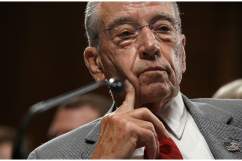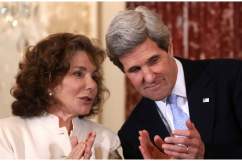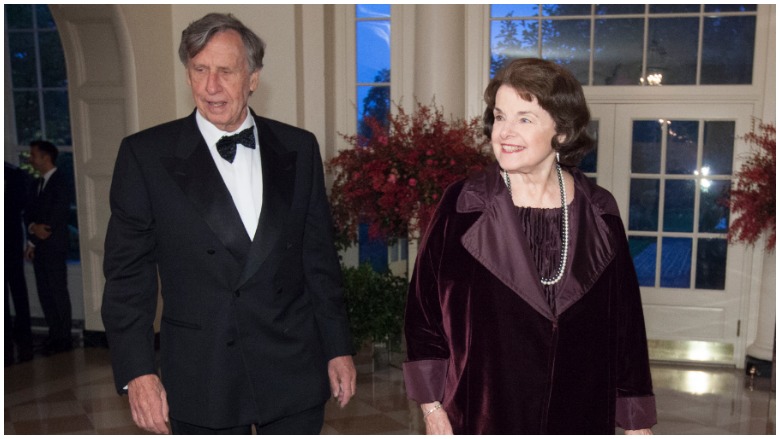
Getty Senator Dianne Feinstein and Richard Blum arrive at the State Dinner for China's President President Xi and Madame Peng Liyuan at the White House for an official State Visit September 25, 2015 in Washington, D.C.
Richard Blum was married to Senator Dianne Feinstein, who has been representing California in Congress since 1992. The couple had been married since 1980. The marriage was Feinstein’s third.
Blum was a successful investment banker with an estimated net worth of $1 billion. Blum battled cancer and died on February 27, 2022, as Mercury News reported. He was 86.
Here’s what you need to know.
1. Richard Blum Met Dianne Feinstein in 1977 Through San Francisco Politics
Richard Blum remained out of the public and political spotlight for the majority of his professional life. But his job in the late 1970s put him in the same circles as his future wife. They reportedly first met in 1977.
Blum was working as an adviser to Mayor of San Francisco George Moscone. Dianne Feinstein was a member of the San Francisco Board of Supervisors. She was also married to her second husband at the time, neurosurgeon Bertram Feinstein. He died of colon cancer in 1978.
Blum and Feinstein found themselves in the middle of a crisis that year. On November 27, 1978, Mayor Moscone was assassinated, along with supervisor Harvey Milk. Former Board of Supervisors member Dan White shot them both at the government offices; Feinstein was the first person to find Harvey Milk’s body. She also addressed the crowd at City Hall, explaining what had happened. White was later found guilty of voluntary manslaughter.
Feinstein became the acting mayor of San Francisco, then was elected to the position in 1979. Blum supported Feinstein’s political ascent. It’s unclear exactly when they started dating, but they got married in 1980 at San Francisco City Hall.
An engagement announcement published March 5, 1979, stated that this was the second marriage for Richard Blum. He was previously married to Andrea Schwartz, with whom he shared three daughters.
2. Richard Blum Founded the Private Equity Firm Blum Capital in 1975, and His Personal Net Worth Was Estimated to be Close to $1 Billion
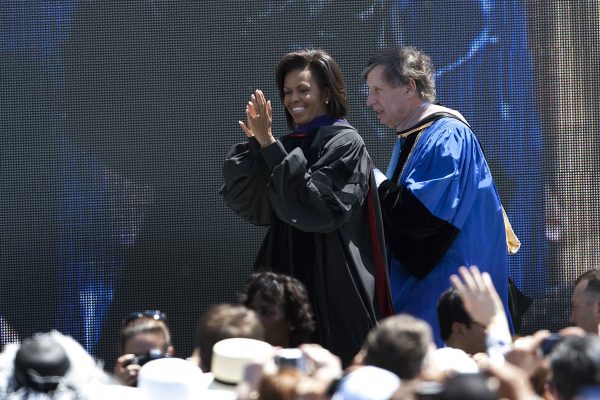
First Lady Michelle Obama walks into the commencement ceremony with Richard C. Blum, chairman, Regents of the University of California, before making the commencement speech at the University of California, Merced on May 16, 2009 in Merced, California.
Richard Blum was a giant in the investment banking world. He founded Blum Capital in 1975 in San Francisco. The home page of its website describes the company as an “investment management firm specializing in corporate private equity transactions.” At age 83, Blum remains chairman of the company.
Blum Capital has invested in dozens of companies since its founding. Its portfolio includes commercial real estate firm CBRE, retail stores including Michaels and Tiffany & Co., media companies such as Getty Images and SBA Communications, and a long list of health care and financial services companies.
In 2015, Richard Blum’s net worth was estimated at about $1 billion but before his death, he was not listed on Forbes’ real-time list of the world’s billionaires. Regardless, his financial holdings make him one of the wealthiest senate spouses on Capitol Hill.
3. Blum and Feinstein Own Several Homes and a San Francisco Hotel
Adding to the personal wealth of Richard Blum and Dianne Feinstein are their real estate holdings. They own the Carlton Hotel in San Francisco, which is part of Carlton Hotel Properties L.P. According to the Los Angeles Times, the company was valued as much as $25 million in 2016.
The San Francisco Chronicle also reports that the couple owns at least four private homes. In 2006, Blum and Feinstein purchased a mansion in San Francisco’s Pacific Heights neighborhood. The home was worth about $16.5 million and used to belong to George Lucas, the creator of Star Wars. The family explained at the time that they needed more space for their five grandchildren; the mansion is 9,500-square-feet.
While in Washington, D.C. Blum and Feinstein live in an estate in Spring Valley near American University. The home was reportedly valued at just under $6 million when Blum and Feinstein moved in, in 2002. According to Washington Life, the home was described as a “French Renaissance revival estate.” The house has four bedrooms, a swimming pool, guest house and a greenhouse.
The couple also owns a vacation home in Aspen, Colorado. The home reportedly sits on 30 acres of land and is worth an estimated $7.4 million. Blum and Feinstein’s other reported properties include a condo on Lake Tahoe and a condo on the Hawaiian island of Kauai.
4. Richard Blum’s Extensive Investments in China in the Late 1990s Prompted Questions About Possible Conflicts of Interest For His Wife
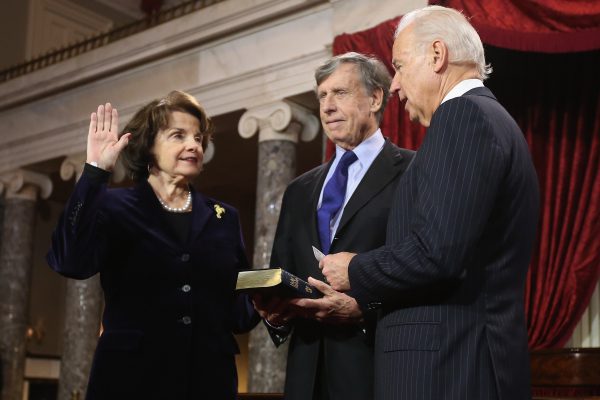
GettyU.S. Sen. Dianne Feinstein (D-CA) (L) participates in a reenacted swearing-in with her husband Richard C. Blum and U.S. Vice President Joe Biden in the Old Senate Chamber at the U.S. Capitol January 3, 2013 in Washington, DC.
Richard Blum’s vast array of financial assets included investments in China. In 1992, his interests in China were valued at less than $500,000. But according to a 1997 report in the Los Angeles Times, Blum’s investments significantly increased in the years after his wife became a senator.
In 1996, Blum reportedly invested $23 million into a steel company owned by the Chinese government. His firms also acquired assets in companies that produce soybean milk and candy, according to the LA Times report.
A 1997 article in the New York Times also reported that Blum’s private equity firm had investments with Shanghai Pacific, a company that produces items such as clean water pumps and firefighting pumps, and Golden China, a technology company that manufactures computer accessories.
Critics wondered if Beijing would try to use Richard Blum’s investments as a way to gain favor with Senator Feinstein. She has insisted that she was not influenced by her husband’s business dealings, telling the NY Times, “We have built a firewall. That firewall has stood us in good stead.”
In 1996, Senator Feinstein sat on the East Asian and Pacific Affairs subcommittee, which is part of the Foreign Relations Committee. Part of the subcommittee’s job was handling relations between the U.S. and China. Senator Feinstein had been an advocate for expanded trade with China and was instrumental in making China a member of the World Trade Organization in 1999.
That same year, a spokesperson for the senator said that Blum had divested of his holdings in mainland China. But according to a report in the San Francisco Chronicle in 2000, Newbridge Capital, a venture capital firm supported by Blum’s firm, continued to own stock in Chinese corporations worth millions of dollars.
The senator has come under new scrutiny more recently in relation to China. In 2013, the FBI discovered that a Chinese-American spy had been working in Senator Feinstein’s office since 1996, and had been reporting back to China’s Ministry of State Security. Feinstein said the staffer was immediately let go from her office after the FBI discovered who he really was, and insisted that the staffer had never had access to sensitive information.
5. Richard Blum Launched a Foundation to Help Communities in Tibet and Used to Fly the Dalai Lama on his Private Jet
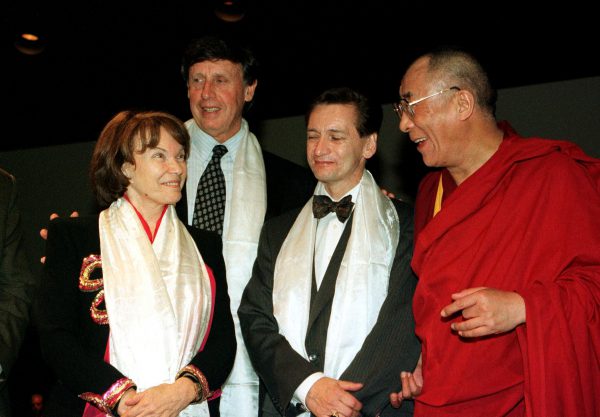
GettyThe Dalai Lama(R) poses with Danielle Mitterrand(L), the former First Lady of France, Richard Blum(2nd L), a Californian Philanthropist, and Riki H. Chambers(2nd R), from the British House of Lords, in Los Angeles October 11, 1999.
Richard Blum had a lifelong fascination with the Himalayan region. He shared in a 2003 interview that he developed a love of hiking as a child, when his family would explore the Sierra Nevada. Blum became interested in the Himalayas after he was given a subscription to National Geographic.
Blum got his wish in 1968 when he traveled to the region for the first time. He hiked the Kali Gandaki Valley in Nepal. He told the San Francisco Chronicle, “The first night we stayed at a Tibetan refugee camp near Pokhara. Little children who’d walked barefoot across the Himalayas to get there would sit on my lap and smile and laugh. I was a goner.”
In 1981, Blum launched the American Himalayan Foundation. the organization operates dozens of schools, orphanages, and other aid programs in Nepal. Workers also help operate Tibetan refugee camps and medical clinics. The same year the foundation launched, Blum also attempted to climb Mount Everest but his team was forced to turn back due to weather.
Richard Blum’s has reportedly tried to use his business connections to ease the relationship between China and Tibet. McClatchy Newspapers reported in 2008 that Blum had a personal relationship with the Dalai Lama; Blum even flew the religious leader on his private jet. Blum and Senator Feinstein also delivered letters from the Dalai Lama to China’s then-president, Jiang Zemin, during the 1990s, asking for a meeting. Blum said in an interview that the lack of progress was frustrating. “There is nothing in my life where I have spent more effort– flown, talked, attended meetings in Beijing and everywhere else, and had so little to show for it.”
